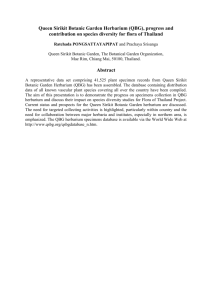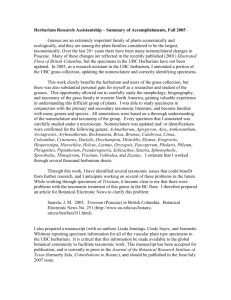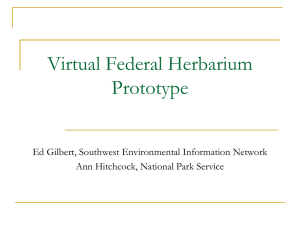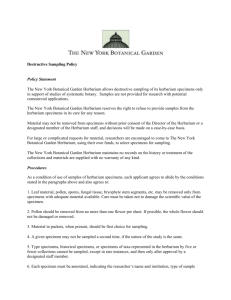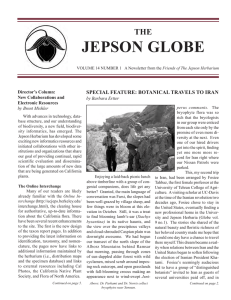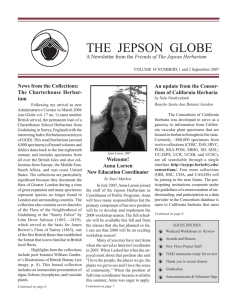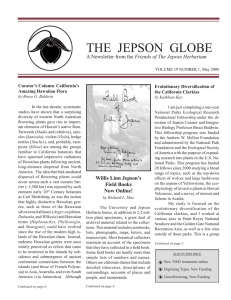THE JEPSON GLOBE Friends of The Jepson Herbarium
advertisement
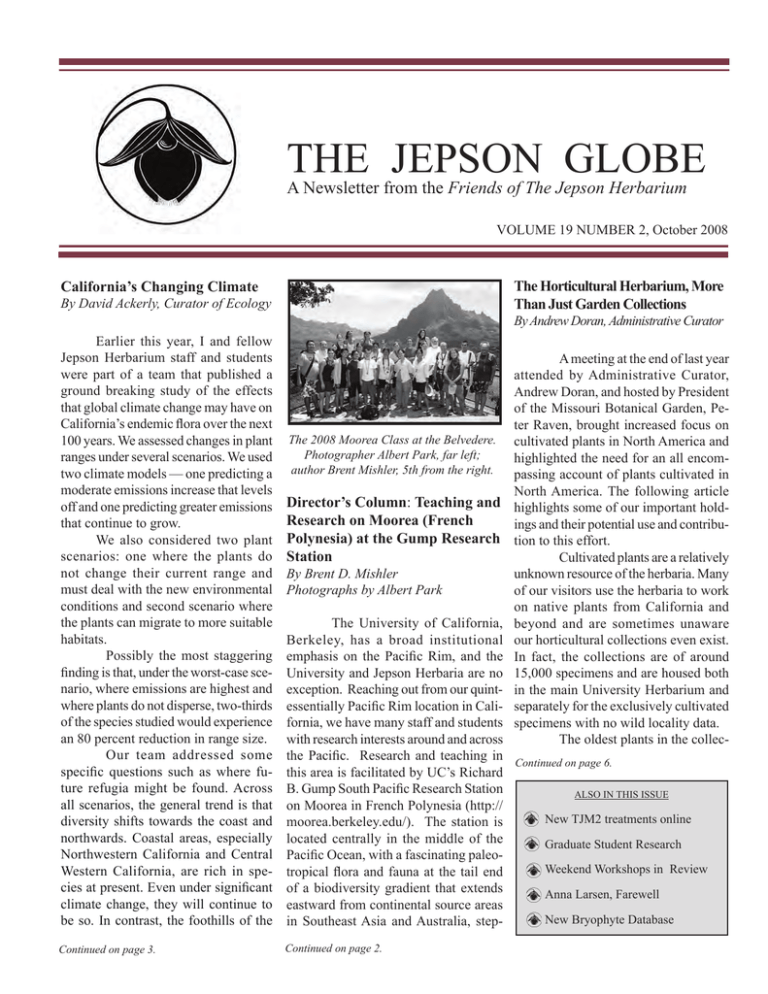
THE JEPSON GLOBE A Newsletter from the Friends of The Jepson Herbarium VOLUME 19 NUMBER 2, October 2008 The Horticultural Herbarium, More Than Just Garden Collections California’s Changing Climate By David Ackerly, Curator of Ecology By Andrew Doran, Administrative Curator Earlier this year, I and fellow Jepson Herbarium staff and students were part of a team that published a ground breaking study of the effects that global climate change may have on California’s endemic flora over the next 100 years. We assessed changes in plant ranges under several scenarios. We used two climate models — one predicting a moderate emissions increase that levels off and one predicting greater emissions that continue to grow. We also considered two plant scenarios: one where the plants do not change their current range and must deal with the new environmental conditions and second scenario where the plants can migrate to more suitable habitats. Possibly the most staggering finding is that, under the worst-case scenario, where emissions are highest and where plants do not disperse, two-thirds of the species studied would experience an 80 percent reduction in range size. Our team addressed some specific questions such as where future refugia might be found. Across all scenarios, the general trend is that diversity shifts towards the coast and northwards. Coastal areas, especially Northwestern California and Central Western California, are rich in species at present. Even under significant climate change, they will continue to be so. In contrast, the foothills of the Continued on page 3. The 2008 Moorea Class at the Belvedere. Photographer Albert Park, far left; author Brent Mishler, 5th from the right. Director’s Column: Teaching and Research on Moorea (French Polynesia) at the Gump Research Station By Brent D. Mishler Photographs by Albert Park A meeting at the end of last year attended by Administrative Curator, Andrew Doran, and hosted by President of the Missouri Botanical Garden, Peter Raven, brought increased focus on cultivated plants in North America and highlighted the need for an all encompassing account of plants cultivated in North America. The following article highlights some of our important holdings and their potential use and contribution to this effort. Cultivated plants are a relatively unknown resource of the herbaria. Many of our visitors use the herbaria to work on native plants from California and beyond and are sometimes unaware our horticultural collections even exist. In fact, the collections are of around 15,000 specimens and are housed both in the main University Herbarium and separately for the exclusively cultivated specimens with no wild locality data. The oldest plants in the collec- The University of California, Berkeley, has a broad institutional emphasis on the Pacific Rim, and the University and Jepson Herbaria are no exception. Reaching out from our quintessentially Pacific Rim location in California, we have many staff and students with research interests around and across the Pacific. Research and teaching in Continued on page 6. this area is facilitated by UC’s Richard B. Gump South Pacific Research Station ALSO IN THIS ISSUE on Moorea in French Polynesia (http:// New TJM2 treatments online moorea.berkeley.edu/). The station is located centrally in the middle of the Graduate Student Research Pacific Ocean, with a fascinating paleoWeekend Workshops in Review tropical flora and fauna at the tail end of a biodiversity gradient that extends Anna Larsen, Farewell eastward from continental source areas New Bryophyte Database in Southeast Asia and Australia, stepContinued on page 2. Moorea, continued from page 1. A composite photo taken looking north from the spine of the island. Mt. Mouaroa (an emblem of Moorea) is at far left, Opunahu Bay is on the left, Cook’s Bay (where Gump Station is located) is on the right. Mt. Rotui is prominent in the center. wise through the island groups of the South Pacific to French Polynesia (east of which is a large expanse of ocean). The biota is thus much less diverse than the source areas and shows “taxonomic disharmony” — i.e., with some groups like ferns and bryophytes forming a disproportionately large fraction of the flora and other groups like orchids a disproportionately small fraction. Interesting ecological questions arise, given this small and biased subsample of the southeast Asian biota, such as how are niches filled in a low-diversity region versus a high-diversity region? The interesting flora and fauna, which is representative of tropical ecology yet of manageable size to learn, is ideal for teaching students whose backgrounds are in temperate California. Of course, the beauty of the island, reputed to be the among the most beautiful in the world, helps keep their interest high also! The premier undergraduate class taught at the Gump Station is UCB’s Biology and Geomorphology of Tropical Islands, for which I am one of several professors each fall (and Albert Park is a current undergraduate). This is a rare class in undergraduate education, an interdisciplinary course open only by application and interview, that occupies one whole semester (13 units), with a student to teacher ratio of nearly 2:1, featuring all-inclusive research experience and full immersion in the life of science and a foreign culture. The 21 students spend a month in Berkeley for lectures and labs five days a week, then go to the Gump Station on Moorea for nine weeks to carry out an intensive research project as well as participate in general educational field trips and group projects, finally returning to Berkeley for two weeks of non-stop data analysis, library research, and writing. Following a round of peer reviews, the students prepare camera-ready copies of their papers for publication in the annual class book (with some submitted to the professional literature as well!) and give an oral presentation in a professionalstyle symposium. Class members form bonds with each other and the teaching staff that will last a lifetime. About five professors (who each spend two to four weeks on Moorea) and three Graduate Student Instructors (who spend the whole nine weeks!) have a unique opportunity to help each student design their project and assist them in the analysis and write-up phase. This close living and working situation allows the transfer of fundamental methods, theories, and even attitudes about science, in addition to the expected transfer of basic information about islands and their biology. It is extremely rewarding for us to see students transform into research scientists in front of our eyes! The class began in 1991, and many participants have gone on to graduate school and are now becoming professors themselves! Research is another area of emphasis at Gump Station. The major current project is the Moorea Biocode Project, which involves many teachers and graduates of the class. The goal of this project (http://www.berkeley. edu/news/media/releases/2007/12/06_ moorea.shtml), funded by the Moore Foundation for $5.2 million, is to inventory every single species of multicellular organism on the island, or in the lagoon. We called it “biocoding” to indicate that our approach is an Students on a hike in the jungle. Gump Station from the waters of Cooks Bay. On a field trip to the motu — small reef islands that form on the barrier reef. 2 Continued on page 3. Moorea, continued from page 2. improvement over “DNA barcoding” — initial approaches to which were too limited and controversial, given the potential non-evolutionary connotations of a “barcode.” Campbell’s Soup cans of a particular type can bear a barcode because they are identical to each other, but organisms in a species are not. [I will lead a discussion of this topic at the December 3rd Science Cafe — see advertisement elsewhere in this issue.] The Moorea Biocode Project is looking at multiple populations for each species, getting museum or herbarium vouchers and pictures of everything, and making keys and morphological descriptions as well as sequencing lineage-specific genes for every specimen. It is really just an old-fashioned biotic survey, with the addition of advanced computer infrastructure and high-throughput DNA sequencing. There are teams working on various groups of plants, animals, fungi, and algae. My lab is taking primary responsibility for ferns and bryophytes, as well as assisting with the flowering plants. A former undergraduate student (Joel Nitta — concentrating on ferns) and a current undergraduate student (Elaine Fok — concentrating on liverworts) from my lab are working with me (concentrating on mosses) this semester in Moorea. We have made several hundred collections so far and have added many taxa to the known flora of the island. Current Bryolab graduate student Ben Carter will begin working on the project in spring, first coordinating the lab work on bryophyte DNA sequencing, then traveling himself to Moorea to continue the collecting. This ambitious and novel attempt to inventory, biocode, and database a complete ecosystem will have many applications to research, conservation, sustainable use, and teaching in the future. Climate, continued from page 1. northern Sierra Nevada are extremely TJM2 treatments vulnerable to species loss. Under scenarios that allow dispersal, the areas posted since that straddle the California-Oregon May 2008 border also become rich in species — as expected from northward dispersal. http://ucjeps.berkeley.edu/ There is one important caveat — the jepsonmanual/review/ potential for areas to act as refugia Apocynaceae: Amsonia, Apocydepends greatly on whether species num, Araujia, Asclepias, Caare able to disperse into them. tharanthus, Cycladenia, Funas We also addressed where spetrum, Matelea, Nerium, Vinca cies will move. As one might expect, Apodanthaceae: Pilostyles species tend to move to higher elevaAponogetonaceae: Aponogeton tions and often northward. InterestCampanulaceae: Downingia, ingly, these trends result in divergent Lobelia projections for elements of the flora. Commelinaceae: Commelina, Given California’s geography, moveTradescantia ment to higher elevations often means Crossosomataceae: Crossotaking a southward path. Within the soma, Glossopetalon six major regions, substantial numbers Droseraceae: Drosera of species move in diametrically opFagaceae: Chrysolepis, Lithposite directions — typically north of ocarpus, Quercus northwest, and south of southeast. In Martyniaceae: Proboscidea the Cascade Ranges and the Sierra NeOxalidaceae: Oxalis vada, species at high elevations tend to Paeoneaceae: Paeonia move south to higher elevations. Those Platanaceae: Platanus at lower elevations, like those in other Rosaceae: Fragaria, Peraphylregions, are a mix of species, some lum of which move south and others that Simaroubaceae: Ailanthus, move north. In short, even relatively Castela moderate projections suggest that cliSimmondsiaceae: Simmondsia mate change has the potential to break Staphyleaceae: Staphylea up local floras, resulting in new species Urticaceae: Boehmeria, Hesmixes, with consequent novel patterns perocnide, Parietaria, Soleiroof competition and other biotic interaclia, Urtica tions. It seems certain that the temperature and rainfall patterns in California will change considerably during the next century. Projecting future change is a crucial step towards planning for and mitigating the impacts of climate change on biodiversity and this study has provided important insight. We are now planning additional projects, including a study of local adaptation to determine if populations of widespread species are climatically specialized, and applied projects to address how our results can be used by land managers in the management of protected areas. The work was supported by data from The Jepson Manual and the participants of the Consortium of California Herbaria. The full article is available here: http://www.plosone.org/article/info:doi/10.1371/journal.pone.0002502 and range projections for specific taxa are available here: http://ucjeps.berkeley.edu/ jepsonflora/CAFP_climate_change/index.html 3 Graduate Students Affiliated With The University and Jespon Herbaria Ben Carter My dissertation research focuses on the ecology and systematics of Scleropodium, a small genus of mosses from North America and Europe. I am interested in using molecular phylogenetics to uncover the diversity within the genus that has previously been unrecognized, as well as elucidating the evolutionary relationships and biogeographic patterns that emerge with revised circumscriptions of taxa within the genus. In addition, I am doing fieldwork in northern California to explore the ways that water availability, both too much and too little, affects the relationships among moss life history strategies, local distributions, and ecophysiolocial constraints. Christopher DiVittorio I am interested in species ranges and adaptation in the genus Encelia, a group of about 20 perennial sunflowers that appear to have radiated recently throughout the Mojave, Sonoran, and Baja California deserts. These sunflowers exhibit a wide range of leaf traits that seem to correlate with the different climatic and edaphic habitats they occupy. Interestingly, although species readily hybridize in the greenhouse, hybrids are conspicuously absent in nature even where different species grow in sympatry. The geologic history of the North American deserts provides some insight into this phenomenon: species ranges match up with the locations of putative late Miocene habitat islands in the Baja California Peninsula. Thus, the rifting of the peninsula from mainland Sonora ~6 mya, and the trend towards increasing aridity over the past 10 mya suggests that Encelia diversified in response to the onset of desert climates and regional changes in habitat availability and connectivity. 4 Matt Guilliams My research includes studies of Calyptridium and closely related Cistanthe, systematics of Plagiobothrys sect. Allocarya, evolution in California vernal pools ecosystems, niche modeling, conservation of the endemic manzanita, Arctostaphylos rainbowensis, from southern California, and general patterns of niche evolution in southern California manzanita species. I am also deeply interested in plant conservation biology and intend to focus on projects that will result in increased awareness and/or protection of California’s rare plants. Christopher Hobbs My research centers on the human uses of plants—ethnobotany and ethno-pharmacology. I am investigating the evolutionary significance of the complex and diverse chemistry of plants, and their pharmacological actions using phylogenetic methods and phytochemical analyses. How is the production of the secondary compounds related to animal interactions through millions of years of evolution, including human interactions? These chemicals may be analogous to the nervous system of animals in that plants use them to perceive and respond to the environment, as well as for protection and communication. I’m focusing on the medicinal genus Artemisia and related lineages, and, using phylogenetic methods, I would like to clarify their ancestry and migrations in and out of North America and Hawaii. I am also analyzing the volatile terpenes from Artemisia species and from the Asteraceae in general, to determine whether they might have phylogenetic significance using small polymer microextraction and gas chromatography/ mass spectroscopy. It is possible to characterize up to 150 different compounds or more from a typical plant in this group— offering tremendous variation and complexity for study. Ekaphan (Bier) Kraichak My research interests center around community ecology and biogeography of cryptogams, particularly mosses and lichens. How do communities form? What environmental factors influence formation of cryptogam communities? I am also interested in relationships between mosses and lichens. Why do they co-exist? What types of relationship do they have (mutualistic or antagonistic)? What are evolutionary explanations for such relationships? With collaboration with several universities in Thailand, I also plan to work on biogeography and community structure of mosses and lichens in various parts of Thailand. I hope to develop some comparative studies that will reveal some underlying differences in ecology of these groups in tropical and temperate systems. Nathan Kraft While tropical forests have inspired more theories of species coexistence than perhaps any other habitat, a synthetic understanding of the forces that shape patterns of species distribution and abundance within these communities has remained elusive. My research focuses on understanding how different ecological processes, such as competition, habitat association, and dispersal limitation, change in importance across spatial scales from meters to kilometers within an upland rainforest in Amazonian Ecuador. I use a set of methods that considers the distribution of ecophysiological traits and phylogenetic relatedness within a community and a variety of statistical null models to make inferences about ecological processes. Susan Tremblay My research is focused on the evolution of liverworts, living representatives of the earliest diverging land plant lineage. Morphologically, liverworts are a diverse group; and, while some taxa do appear to be isolated ‘relicts,’ others have undergone extensive recent adaptive radiations. I am particularly interested in the unique, membrane-bound organelles called oil bodies found in the cells of 90% of liverwort species but in no other plant groups. These conspicuous, often colorful structures are distinctive and have long been used for taxonomic purposes; yet, little is known about them beyond their appearance. I am currently looking at their diversity within and between clades for evidence of trends that could lead to testable hypotheses regarding oil body function. I am also interested in the special adaptations of the complex thalloid liverworts that thrive in California’s Mediterranean climate and for the last three years have been conducting a phenological study of local populations of Cryptomitrium tenerum. Photo: gametophyte of Cryptomitrium tenerum supporting five sporophytes with mature sporangia. The Jepson Herbarium Projects & Resources The Jepson Flora Project Second Edition of The Jepson Manual Online Interchange for California Florisitcs Jepson Desert Manual Online Horticultural Database Electronic Publication of Jepson’s A Flora of California Ecological Flora of California Publications & Research Projects Constancea: University of California electronic publications in botany Flora of Mount Diablo Building the Tree of Life A National Resource for Phyloinformatics and Computational Phylogenetics Deep Green Plant Phylogenetics: Novel Analytical Methods for Scaling Data from Genomics to Morphology Systematics and Evolution of California tarweeds and relatives (tribe Madieae, Compositae) Unravelling the dynamics of mating-system evolution in tribe Collinsieae Niche conservatism, functional trait evolution, and the diversification of the California vernal pool flora Flora of the East Bay North American Potentilleae Evolution and origin of Calif. alliums Educational Services & Resources Botanical Workshops & Courses Plant Identification 2,200,000+ Worldwide Plant Specimens Botanical Library & Archives Administration Trustees: Vice Chancellor Emeritus Roderic Park, Chairman; Vice Chancellor Beth Burnside (on leave); UC Botanical Garden Director, Paul Licht; Professors John Taylor and Brent Mishler (ex officio) Director: Professor Brent Mishler Curator: Professor Bruce Baldwin Research Associate: Bridget Wessa Jepson Flora Project Staff: Project Research Specialists: Jeff Greenhouse, Scott Simino Project Manager: Staci Markos Manag. of Collections Data: Richard Moe Scientific Editor: Tom Rosatti Admin. Assistant: Edith Summers Managing Editor: Margriet Wetherwax Administrative Curator: Andrew Doran Collections Management Staff: Kelly Agnew, Heather Driscoll, Rebecca Guenther, Kim Kersh, and Ana Penny Research Botanist: Barbara Ertter Public Programs: Anna Larsen Development & Globe Editor: Staci Markos 5 Horticultural Herbarium, continued from page 1. tions come from the recently acquired Charterhouse School Herbarium or GOD (from the town of GODalming, Surrey, U.K.), if being referred to by its standardized Index Herbariorum designation. Many of these specimens were acquired by the Reverend Tullie Cornthwaite (1807-1878), a local vicar and philanthropist, closely associated with Forest School in northeast London. Cornthwaite, in addition to his own volumes, acquired vouchers from famous estates and gardens, many of which have been destroyed or built over. These include (amongst others) specimens from the famous Loddiges nursery in Hackney, many historic London gardens (see below), and from the Whiteknights estate of George SpencerChurchill (1766-1840), the Marquis of Blanford, which eventually became the main campus of Reading University, well renowned for its botanical and horticultural programs. Naturally, there are vouchers from Kew Gardens, but also in GOD are specimens from another less known London garden, Isaac Swainson’s now demolished botanical garden in Twickenham. A short distance from Kew, this garden was observed by garden designer, botanist, and horticultural journalist, John Claudius Loudon (1783-1843), who wrote that it “contained every tree and shrub that could be procured at the time in the British nurseries…” Such specimens are a record of plants in cultivation during a period when novelties from around the world were highly sought after. These remaining vouchers are the records of some of the first introductions into cultivation, the dates and times being vital clues to retracing the steps of botanists and the development of collections. Another garden, sadly no longer extant, is represented by a fascinating lot of several thousand vouchers of renowned landscape architect and Berkeley aluma, Beatrix Farrand, the only woman of the original founders of the American Society of Landscape Architects. The vouchers are all from 6 Label data from the back of this specimen reveals, ‘Hort. Chelsea Fairbairn,’ a specimen of Aristolochia sipho L’Hér., now Aristolochia macrophylla Lam., collected in London’s ‘Chelsea Physic Garden,’ under the curation of John Fairbairn, who was employed there from 1784 till his death in 1814. Most of our vouchers from this garden were collected in the 1790’s. The plant is annotated as “…reported to cure bite of venomous serpents” in the hand of the Rev. Tullie Cornthwaite, however today plant roots are often seen for sale in homeopathic pharmacies. The high resolution scan enabled us to send a digital image to an Aristolochia expert in Brooklyn Botanical Garden who confirmed the identity of this specimen as A. macrophylla Lam. As well as verifying existing accession data for the garden, more recent ethnobotanical vouchers are frequently used for classes on the Berkeley campus. one of her last projects to create a landscape study center at Reef Point, Maine. These specimens precisely document the planting design (see image below), and her use of native plants (and cultivars of native plants) is central to the current objectives and horticultural data contained in The Jepson Manual and subsequent horticultural database, to document and promote the use of native Californian plants including those with Continued on page 7. Above. Typical specimen label from Farrand’s Reef Point Garden, using a hybrid of the native Vaccinium corymbosum L. Communication with former Herbaria Director, Herbert Mason indicates very precise plans to house her collections within the University Herbarium. This collection was made by Miss Marion Spaulding, a graduate of the Rhode Island School of Design. Note that the labels contain individual maps of the garden beds and locations of plants (e.g., Sec. No. 57), information vital to garden conservationists for recreating bed designs and identification of native plants. It is vouchers themselves that confirm the identity of what was planted; what is desired on a landscape drawing is often not what is available in a nursery. Horticultural Herbarium, continued from page 6. not always the targeted collections of California botanists they were often overlooked and under collected. The cultivated collection has some of the first records of ornamentals such as Cortaderia selloana (Schult. & Schult. f.) Asch. & Graebn. that eventually became invasive, and these collections assist our knowledge of the spread of invasives and lead to a greater understanding of invasive plant ecology and Jepson Flora Project researcher, Jeff support informed conservation manageGreenhouse standing next to a Giant Chilment. ean Rhubarb, Gunnera tinctoria (Molina) Some of our specimens are the Mirb., over eight feet high, now naturalized in Point Reyes National Seashore and cultivated equivalent of a type specimen Tomales Bay State Park. What started as known as ‘standards’ and are the specia fascinating ornamental has now found men to which the name of a new cultivar heavily grazed, moist, sloping, seeps an is permanently attached. A recent accesattractive alternative to its native Chile. sion of the waterlily, Nymphaea ‘Stan Growing on tussocks and out of the preSkinger’ is one such example. Like vailing winds it is a truly bizarre sight in the many cultivars, preservation and docuCalifornia landscape. Collecting escaped mentation of attributes (such as color, ornamentals also documents the early scent, flowering times, and parentage) detection of, and hopefully rapid response that make them unique from closely to, new invasions. related cultivars pose many curatorial and observational challenges. In addition, there is a separate code of nomenclature for cultivated plants dealing with the inevitable complexities of assigning nonlatinized names for cultivars that have been developed for hundreds of years. Specimens closer to home are vouchers from the UC Botanical Garden that document the collections, complement living accession records, and can be collected at our leisure, thus documenting different morphology at different times of the year. The garden maintains excellent accession records and, unlike a number of ornamental collections, data associated with Botanist Andrew Doran (right) collecting on Alcatraz Island in April 2008. Some of the long neglected prison gardens are being restored by the Garden Conservancy. Unsurprisingly, few the living plants is so detailed collections have been made on the island (just 3 out ~1,000,000 consortium records), but past that despite being cultivated inventories and historic photographs show that a surprising diverse range of plants grown by the resulting vouchers are filed inmates (left) and current garden staff, which will complement a cultivated flora project for with the main wild collections the Bay Area. Photo of inmate taken by prison guard Joseph H. Simpson, a guard on the island in the University Herbarium. from 1934-1946 (courtesy of Joan Simpson Moore). Alcatraz is potentially the localized genotypes. Farrand’s projects aside from Reef Point included Dumbarton Oaks, the Santa Barbara Botanic Garden, and The Huntington Botanical Gardens. Her association with a renowned English garden designer is another British connection and the reason why landscape plans, correspondence, and photograph albums of Gertrude Jekyll are housed in the College of Environmental Design archives. When Farrand was unable to raise funding for the secure future of Reef Point, she had the house and garden dismantled but the specimens continue to tell its story and now may prove invaluable for restoration projects. The Garden Conservancy is currently engaged in restoring her final home garden at Garland Farm on Mt Desert Island, Maine, and also, more locally, the prison gardens of Alcatraz Island (see below). Because invasive plants were Continued on page 8. 7 Farewell to Friends from Anna Larsen Once again, planning for the upcoming year of Jepson Herbarium Public Programs is in full swing! We have a suite of exciting botanical forays, special programs, and taxonomic adventures planned for 2009. Sadly, after seven years at the University and Jepson Herbaria as both a graduate student and the Coordinator of Public Programs, the time has come for me to leave the nest! I accepted the position as the program coordinator last summer, during the final months of writing my dissertation. Having been involved with the program since 2003 as both a volunteer and a guest coordinator, I was thrilled at the opportunity to take the helm and have enjoyed the experience. Anna in Venice, Italy, summer 2007 In reflecting on the past year, I certainly have many personal highlights. First, I learned an important life lesson: manzanitas and rushes can be identified and are not to be feared! I also made my first trip to the Channel Islands to meet many endemics I’d seen only in the UC Botanical Garden. The workshop was memorable not only for the plants and the spectacular views, but also for the adventurous driving, the marine life, and the feeling that I had traveled backward in time to see California the way it was two hundred years ago. The Jepson Herbarium Public Programs is a vivacious component of our botanical community and it takes contributions large and small from many people to be a success. I’m glad to have been a part of the legacy of the program and I’m grateful to the many people who helped to make this season a reality and enriched my experiences as the program coordinator. Upon my departure from the Herbarium, I will continue to be involved with the botanical community in the Bay Area, and I certainly hope to run into many of you while botanizing around California! Horticultural Herbarium, cont. from page 7. start of a new program to voucher cultivated plants. California has a rich history of growing more plants in cultivation than almost anywhere in North America. Like the native and naturalized plants that have preceded them electronically, there is no doubt that a consortium/database approach to the mammoth task of producing a cultivated flora, coupled with our experience with managing on-line data, would greatly assist this project. A great start to such a project would be to capture the historic cultivated flora for California by digitizing the approximately 110,000+ cultivated plants in herbaria throughout California. Duplicates of California collections will also be sent to participating herbaria such as the US National Arboretum herbarium and possibly a set in a European herbarium such as the Royal Horticultural Society’s herbarium in Wisley, Surrey, where specimens could be used for comparative purposes. The RHS conduct plant 8 trials that plan and assess groups of plants for garden decoration or other horticultural use. These trials can often resolve taxonomic and nomenclatural problems occurring in cultivated plants. Curator of the Herbarium at Wisley, Dr. Christopher Whitehouse, communicated that cultivated plants of known wild provenance of genera such as Ceanothus and other Californian plants grown in the U.K. as ornamentals would greatly assist RHS research projects. In addition, specimens would greatly assist members identification queries to RHS botanists when returning home from trips to California. To find out more about our cultivated plants at the herbaria, to arrange a tour of the collections, or to become involved with documenting the collections please contact Andrew Doran at andrewdoran@berkeley.edu. The East Bay Science Café is a forum for discussing scientific issues in a casual evening of conversation. Sponsored by the Berkeley Natural History Museums (bnhm.berkeley.edu). FREE at La Peña Cultural Center 3105 Shattuck Ave., Berkeley, 94705 (www.lapena org). 7 PM to 9 PM Nov. 5, Jerry Powell. Long-term effects of a wildfire on butterfly and moth diversity in coastal California Dec. 3, Brent Mishler. DNA barcoding: benefits and potential pitfalls 2008 YEAR IN REVIEW This has been a great year for the Public Programs. We botanized new locations like the Sierra Valley and the Shasta-Trinity NRA, and returned to some old favorites like Anza-Borrego and the Mojave Desert. Most of our workshops filled to capacity and we welcomed many new workshop participants this year! We expanded the program to offer a training course for the California Department of Transportation and will continue to expand in this direction by offering training opportunities for the Forest Service in 2009. Each year, we strive to recruit the best possible instructors and in 2008 thirteen new instructors joined our host of popular veterans. A special thanks to Edith Summers for the administrative assistance that has been an incredible asset to the Public Programs this year! Photos (clockwise from upper left): 1) Bill Harnach and company enjoy the sweeping views from the floor of Sierra Valley. 2) Dinner is served against a backdrop of Mojave Desert mountains. 3) Kathy Kellison curates her insect collections at the Bee Pollination workshop. 4) Under the tutelage of John Sawyer, workshop participants get up close and personal with Neviusia cliftonii on the Shasta-Trinity workshop. 5) Steve Junak deftly navigates the backroads of Santa Cruz Island in a military surplus vehicle. Photos courtesy of Heather Driscoll, Anna Larsen, Tom Rosatti, and Scott Simono 9 VOLUNTEERS NEEDED TO HELP WITH UC/JEPS BACKLOG CALIFORNIA BOTANICAL SOCIETY FREE LECTURES One Saturday of each month (from 10 AM to 4 PM) is a Group Volunteer Day in the Herbaria at the University of California at Berkeley. Nov 20 Bart O’Brien California Native Plants in Restoration and Landscape Projects Along the Los Angeles and San Gabriel Rivers Our focus will be chipping away at the unmounted backlog of pressed plant collections, from California and around the world, some brand new, some decades old. Volunteers are greatly needed to mount, sort, and file these collections and to assist with related projects. No previous herbarium experience is necessary. March 19 Tom Daniel A Botanical Tour of the “Chocolate Islands:” São Tomé and Príncipe To be added to the Group Volunteer reminder list, please call Ana Penny (510) 642-2465. Opportunities are also available during the week (9-5, M-F). Group Volunteer Saturdays for 2008-2009: Nov 15, Dec 13, Jan 10, Feb 14, Mar 14, Apr 18, and May 9 April 16 Bruce Baldwin Diversification and Diversity of Collinsia (Plantaginaceae) Lectures start at 7:00 p.m. Refreshments will be served before (starting at 6:45 p.m.) and after. 2063 Valley Life Sciences Building, UC Berkeley www.calbotsoc.org Bryophyte data going online! Label data from 95,000 specimens is now available. http://ucjeps.berkeley.edu/bryolab/UC_bryophytes.html The database currently presents data from nearly 70,000 of Dan Norris’s 110,000 bryophyte specimens, 25,000 of Jim Shevock’s specimens, and specimens databased by Paul Wilson at California State University at Northridge. These specimens, mostly georeferenced, are primarily from California, but also worldwide. We are actively curating the UC bryophyte collection (currently about 200,000 specimens total) and we intend to add to this database regularly. We anticipate adding data from other current collectors, including Brent Mishler and the Bryolab graduate students. Eventually we will include the entire UC bryological collection. 10 Friends of the Jepson Herbarium Name(s) _____________________________________________________ Address _____________________________________________________ City, State Zip ________________________________________________ Telephone / email ____________________________________________ __ I would like to contribute to the Annual Fund: ____ join the Friends or ___renew membership ($35 individual / $50 family). I would like to support the second edition of The Jepson Manual with my gift of _________. Please acknowledge me as a sponsor of __________________________ (indicate genus name, e.g., Lilium, family name, e.g., Poaceae, or other category) by printing my name in The Jepson Manual (for gifts of $1,000 or more, see side bar).See http://ucjeps.berkeley.edu/ jeps/friends/sponsored.html for groups that have already been sponsored. Please acknowledge my gift as anonymous. My or my spouse’s employer will match this gift. (Please enclose company form) This gift is ___ in honor of ___ in memory of ______________________ Please make your check payable to UC Regents or charge your gift. ___ Visa ___ Mastercard ___ TOTAL Amount Account # __________________________________________________________ Exp. Date __________________________________________________________ Signature __________________________________________________________ MAIL TO: The Jepson Herbarium 1001 VLSB #2465 University of California Berkeley, CA 94720-2465 OR: Renew Online http://givetocal.berkeley.edu/makeagift/jepson/ All gifts are tax deductible as prescribed by law. Thank you for supporting the Herbarium and its programs! Categories of Giving Gifts to support the Second Edition $25,000 Honor the contributions and founding principles of W. L. Jepson, former Jepson Trustees Lincoln Constance and Robert Ornduff, and former Jepson Curators Rimo Bacigalupi and Lawrence R. Heckard $10,000 Support taxonomic efforts in an organizing unit of the Manual Ferns, Gymnosperms, Dicots, or Monocots $5,000 Support floristic effort for a particular bioregion $2,500 Support taxonomic work in a particular family See the Herbarium web site for an up-to-date, complete list $1,000 Show enthusiasm for your favorite genus Annual Support $500 Contribute to the illustration of a new species $250 Help accession specimens from the backlog $100 Support taxonomic research at the species level $35/$50B a s i c m e m b e r s h i p i n Friends of the Jepson Herbarium S ponsorship opportunities are exclusive and will be available on a first-come, first-served basis. With approval from the donor, gifts at the $1,000 level and above will be acknowledged in the front pages of The Jepson Manual. Gifts may be made as one-time payments or as a pledge. 11 Friends of the Jepson Herbarium Nonprofit Organization U.S. Postage PAID University of California The Jepson Globe, Vol. 19 No. 2 1001 Valley Life Sciences Building #2465 University of California, Berkeley Berkeley, CA 94720-2465 ADDRESS SERVICE REQUESTED Jepson Herbarium Public Programs (preview of the 2009 season) February 2009 Intermediate Bryology, Brent Mishler & Ken Kellman June 2009 Flora of the White Mountains, Jim Morefield Grimmia, Roxanne Hastings Flora of Humboldt Co., Michael Mesler & John Sawyer March 2009 Introduction to Plant Morphology and Identification, Anna Larsen August 2009 Carex, Peter Zika Flora of Yosemite National Park, Steve Botti Fifty Plant Families in the Field, Linda & Dick Beidleman September 2009 Botanical Field Sketching, Linda Ann Vorobik April 2009 Flora of the Saline Valley, Dana York May 2009 Poaceae, Travis Columbus Wetland Restoration, John Callaway Composites and Graminoids: Advanced Plant ID, Linda Ann Vorobik October 2009 From Plant Press to Publication: An Introduction to Herbarium Curation, Andrew Doran For more information, contact Anna Larsen (510) 643-7008, alarsen@berkeley.edu or visit our Web site: http://ucjeps.berkeley.edu/jepwkshp.html Printed on recycled paper, 30% post-consumer
